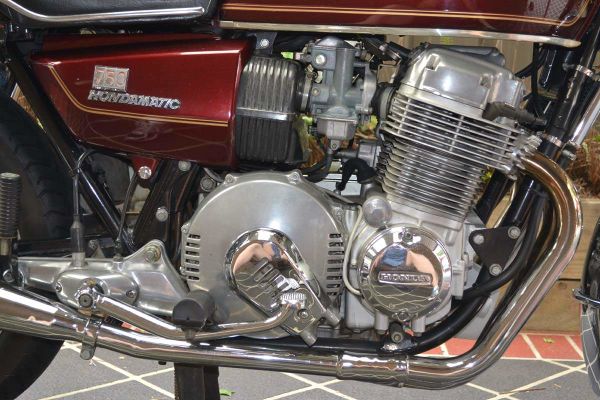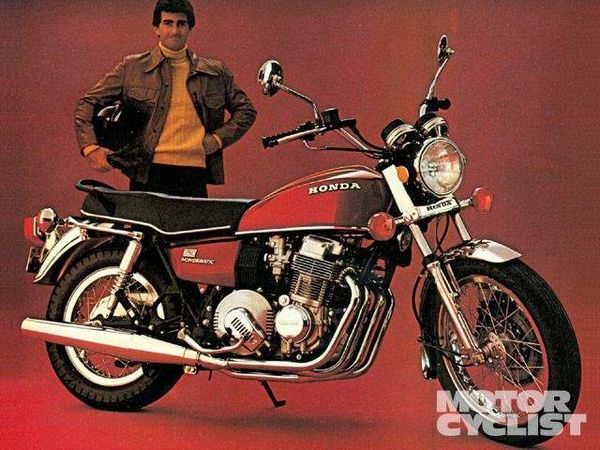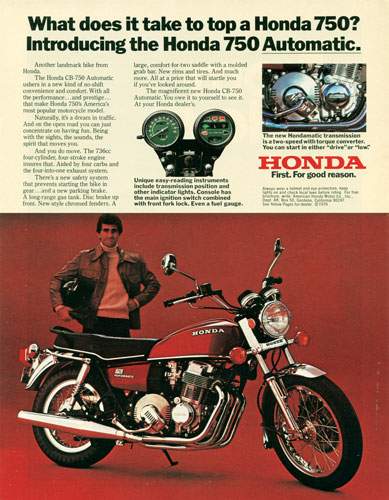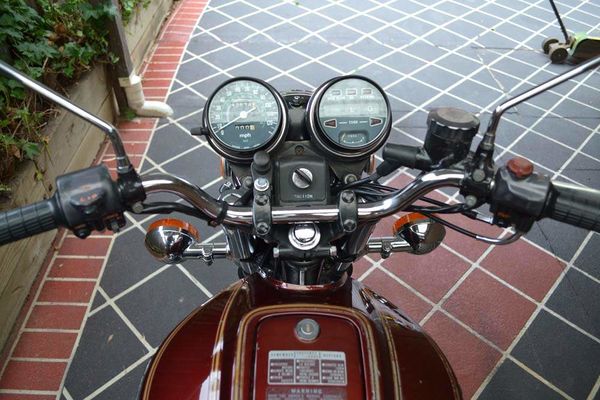Difference between revisions of "Honda CB750A matic"
(initial) |
m (no summary specified) |
||
| Line 35: | Line 35: | ||
|dry_weight = 245 kg / 540.1 lbs | |dry_weight = 245 kg / 540.1 lbs | ||
|wet_weight = | |wet_weight = | ||
|fuel_capacity = 19.5 | |fuel_capacity = 19.5 Liters / | ||
|oil_capacity = | |oil_capacity = | ||
|fuel_consumption = | |fuel_consumption = | ||
| Line 49: | Line 49: | ||
==Chassis== | ==Chassis== | ||
It came with a 3.25-19 front [[tire]] and a 4.00-18 rear tire. Stopping was achieved via Single 296mm disc in the front and a Single 296mm disc in the rear. The front suspension was a Telehydraulic forks while the rear was equipped with a Swingarm with dual shocks.. The CB750A matic was fitted with a 19.5 | It came with a 3.25-19 front [[tire]] and a 4.00-18 rear tire. Stopping was achieved via Single 296mm disc in the front and a Single 296mm disc in the rear. The front suspension was a Telehydraulic forks while the rear was equipped with a Swingarm with dual shocks.. The CB750A matic was fitted with a 19.5 Liters / fuel tank. The bike weighed just 245 kg / 540.1 lbs. The wheelbase was 1480 mm / 58.3 in long. | ||
== Photos == | == Photos == | ||
[[File:Honda-CB750A---2.jpg|600px|Honda CB750]] | [[File:Honda-CB750A---2.jpg|600px|Honda CB750]] | ||
| Line 246: | Line 246: | ||
|- | |- | ||
!Fuel Capacity | !Fuel Capacity | ||
|19.5 | |19.5 Liters / | ||
|- | |- | ||
!Consumption Average | !Consumption Average | ||
Revision as of 02:45, 20 June 2019
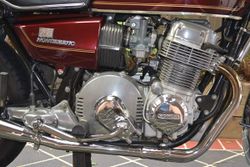 | |
| Manufacturer | Honda |
|---|---|
| Also called | CB750K 2nd. edition, CB 750 K 2nd. edition, CB750A matic, CB 750 A matic, CB750F SS, CB 750 F SS, CB750F 1, CB 750 F 1, CB750F SuperSport, CB750F 2, CB 750 F 2, CB750 (reduced effect #2), CB 750 (reduced effect #2), CB750 (reduced effect), CB 750 (reduced effect), CB750F2 Seven-Fifty, CB 750 F2 Seven-Fifty, CB750 Sevenfifty, CB 750 Sevenfifty, CB750 Seven-Fifty, CB 750 Seven-Fifty, CBX750F, CB750 Seven Fifty, CB750SC Nighthawk, CB750K, CB750F, CB750C, CBX 750 F, CB 750 Seven Fifty, CB 750 SC Nighthawk, CB 750 Nighthawk, CB 750 K, CB 750 F2, CB 750 F, CB 750 C, CB 750, CB750 Nighthawk, CB750F2 |
| Production | 1975 |
| Engine | Four stroke, transverse four cylinder, SOHC, 2 valve per cylinder. |
| Compression ratio | 9.2:1 |
| Top speed | 158 km/h |
| Ignition type | Battery induction coil |
| Transmission | 2 Speed |
| Frame type | Painted steel |
| Suspension | Front: Telehydraulic forks Rear: Swingarm with dual shocks. |
| Brakes | Front: Single 296mm disc Rear: Single 296mm disc |
| Front Tire | 3.25-19 |
| Rear Tire | 4.00-18 |
| Wheelbase | 1480 mm / 58.3 in |
| Weight | 245 kg / 540.1 lbs |
| Fuel capacity | 19.5 Liters / |
| Manuals | Service Manual |
| Tech Specs · Brochures · Reviews · Ads · Videos | |
It could reach a top speed of 158 km/h.
Engine
The engine was a Air cooled cooled Four stroke, transverse four cylinder, SOHC, 2 valve per cylinder.. The engine featured a 9.2:1 compression ratio.
Chassis
It came with a 3.25-19 front tire and a 4.00-18 rear tire. Stopping was achieved via Single 296mm disc in the front and a Single 296mm disc in the rear. The front suspension was a Telehydraulic forks while the rear was equipped with a Swingarm with dual shocks.. The CB750A matic was fitted with a 19.5 Liters / fuel tank. The bike weighed just 245 kg / 540.1 lbs. The wheelbase was 1480 mm / 58.3 in long.
Photos
Overview
Honda
CB750A Hondamatic
The part of riding a motorcycle that newcomers typically find most difficult is balancing clutch and throttle control when taking off from a standstill. So a motorcycle without a clutch should be a no-brainer shouldnt it? Thats presumably what Honda thought when they brought the Honda CB750A Hondamatic to market in 1976. Superficially, the A model can be thought of as a Honda CB750F with a torque converter and two-speed transmission instead of the regular bikes five-speed cog box. In practice, though, the 736cc inline four got pretty much a complete makeover. Revisions to the combustion chambers lowered compression, which, with smaller carbs, camshaft changes and a four-into-one exhaust revised the power curve for more low-down thrust to suit the characteristics of the torque converter. An accelerator pump fitted to the number two carburetor (but feeding all four) helped to alleviate a known flat spot off idle in the standard power delivery of the Honda CB750F. A new Hy-Vo chain drove a jackshaft behind the crank, and powered the torque converters oil pump, with gear drive to the two-speed tranny. To provide an oil bath for the transmission and torque converter, the engines lubrication was switched from dry to wet sump. Just two speeds? With the torque converter doing the hard work, thats all Hondas suits decided it needed. But while the torque converter replaced the clutch, shifting between the two gears was done manually with a conventional foot pedal. The reason? Honda figured an unexpected shift mid-turn might alarm an inexperienced rider arguably their target demographic. In any case, the Honda CB750A would comfortably pull away from a standstill in high gear (drive): it just did it more quickly in low. For the engine to turn when the starter was pressed, the transmission had to be in neutral. And if you forgot to shift into neutral before parking the Honda CB750A, deploying the side stand would do it for you. Both of these features were obviously intended to prevent unintended launches. Similarly, a push-button parking brake acting on the rear wheel prevented the bike from rolling away if parked on a slope, there being no direct gear linkage between engine and wheels. Even after the brake button was released, the brake remained on and the bike wouldnt roll until the rider dabbed the brake pedal. Instruments were also different on the Honda CB750A Hondamatic. No tachometer was fitted, although the speedometer showed the maximum speeds in low and drive, 60 and 105mph, respectively. Idiot lights indicated low, drive and neutral, as well as more usual functions like oil pressure, high beam and turn indicators.
Model History
The CB750A Hondamatic 750 was sold in 1975 in Canada -- one year before it was
offered in the USA. It was available in one of two colors: Muscat Green Metallic
or Candy Antares Red. The exhaust system was a 4-into-1. The bike had wire spoke
wheels with aluminum rims. The transmission was a 2-speed with a fluid torque
converter. The engine was a 736cc SOHC 2-valve air-cooled inline 4 cylinder with
a chain drive. The serial number began CB750A-6000001.
The CB750A'76 Hondamatic 750 was introduced into the USA in 1976 but the Hondamatic had been sold in Canada in 1975. It was available in one of two colors: Muscat Green Metallic or Candy Antares Red. The exhaust system was a 4-into-1. The bike had wire spoke wheels with aluminum rims. The transmission was a 2- speed with a fluid torque converter. The engine was a 736cc SOHC 2-valve air-cooled inline 4 cylinder with a chain drive. The serial number began CB750A-7000001.
The CB750A'77 Hondamatic 750 was sold in 1977 in one of two colors: Candy Sword Blue or Candy Presto Red. The exhaust was now a 4-into-2. The gas tank and side covers had gold pinstripes. The bike had wire spoke wheels with aluminum rims. The transmission was a 2-speed with a fluid torque converter. The engine was a 736cc SOHC 2-valve air-cooled inline 4 cylinder with a chain drive. The serial number began CB750A-7100001.
The CB750A'78 Hondamatic 750 was sold in 1978 in one of two colors: Candy Alpha Red or Candy Polaris Blue. The bike had comstar wheels. The gas tank and side covers had gold pinstripes. The exhaust was a 4-into-2. The transmission was a 2-speed with a fluid torque converter. The engine was a 736cc SOHC 2-valve air-cooled inline 4 cylinder with a chain drive. The serial number began CB750A-7200001.
| Make Model | Honda CB750A Hondamatic |
|---|---|
| Year | 1975 |
| Engine Type | Four stroke, transverse four cylinder, SOHC, 2 valve per cylinder. |
| Displacement | 736 cc / 44.9 cu-in |
| Bore X Stroke | 61 х 63 mm |
| Cooling System | Air cooled |
| Compression | 9.2:1 |
| Induction | 4x 28mm keihin carburetors |
| Ignition | Battery induction coil |
| Starting | Electric |
| Max Power | 69 hp @ 8000 rpm |
| Max Torque | |
| Transmission | 2 Speed |
| Final Drive | Chain |
| Frame | Painted steel |
| Front Suspension | Telehydraulic forks |
| Rear Suspension | Swingarm with dual shocks. |
| Front Brakes | Single 296mm disc |
| Rear Brakes | Single 296mm disc |
| Front Tire | 3.25-19 |
| Rear Tire | 4.00-18 |
| Rake | 62.5° |
| Trail | 115 mm / 4.5 in |
| Wheelbase | 1480 mm / 58.3 in |
| Dry Weight | 245 kg / 540.1 lbs |
| Fuel Capacity | 19.5 Liters / |
| Consumption Average | 15.6 km;/lit |
| Standing ¼ Mile | 15.8 sec |
| Top Speed | 158 km/h |
